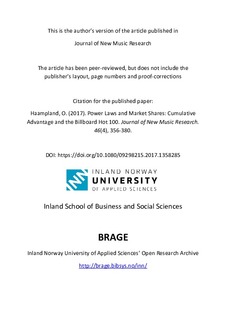| dc.contributor.author | Haampland, Ola | |
| dc.date.accessioned | 2018-02-22T13:35:26Z | |
| dc.date.available | 2018-02-22T13:35:26Z | |
| dc.date.created | 2017-08-07T11:18:02Z | |
| dc.date.issued | 2017 | |
| dc.identifier.citation | Journal of New Music Research. 2017, 46 (4), 356-380 | nb_NO |
| dc.identifier.issn | 0929-8215 | |
| dc.identifier.uri | http://hdl.handle.net/11250/2486517 | |
| dc.description.abstract | The existence of highly skewed success distributions in the music industry has been repeatedly demonstrated by scholars, but there still is no agreement about how these shapes relate to concepts like ‘talent’, ‘reputation’, and ‘quality’. Starting from the theories of Rosen (1981) and Adler (1985), this article concentrates mainly on the phenomenon referred to as cumulative advantage, as one of the leading candidate mechanisms to explain the formation of the ‘power law-like’ distributions found in e.g. the sales of music recordings. We make the case for the pivotal role of the market share approach in the music industry and demonstrate its efficacy as a ‘success measure’ methodology by providing a descriptive summary with regard to ‘connotations’ of cumulative advantage based on fifty years of Billboard Hot 100 history. Our results indicate that, while records that have sold well will keep on selling, the same might not be true for recording artists. However, a modest ‘star power’ effect may have represented a small but vital edge for the oligopoly of multinational recording companies. The methodology suggested in this article should provide students of ‘hit song science’ and the likes with a more rigorous approach to appraising commercial success, as well as a comprehensive background as to its origin and relevance to popular music studies. | nb_NO |
| dc.language.iso | eng | nb_NO |
| dc.rights | Attribution-NonCommercial-NoDerivatives 4.0 Internasjonal | * |
| dc.rights.uri | http://creativecommons.org/licenses/by-nc-nd/4.0/deed.no | * |
| dc.subject | Billboard Hot 100 | nb_NO |
| dc.subject | economics of superstars | nb_NO |
| dc.subject | cumulative advantage | nb_NO |
| dc.subject | market share | nb_NO |
| dc.subject | power laws | nb_NO |
| dc.subject | hit song science | nb_NO |
| dc.title | Power laws and market shares: cumulative advantage and the Billboard Hot 100 | nb_NO |
| dc.type | Journal article | nb_NO |
| dc.type | Peer reviewed | nb_NO |
| dc.description.version | acceptedVersion | nb_NO |
| dc.source.pagenumber | 356-380 | nb_NO |
| dc.source.volume | 46 | nb_NO |
| dc.source.journal | Journal of New Music Research | nb_NO |
| dc.source.issue | 4 | nb_NO |
| dc.identifier.doi | 10.1080/09298215.2017.1358285 | |
| dc.identifier.cristin | 1484493 | |
| cristin.unitcode | 209,98,60,2 | |
| cristin.unitname | Institutt for Økonomifag | |
| cristin.ispublished | true | |
| cristin.fulltext | postprint | |
| cristin.qualitycode | 2 | |

